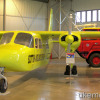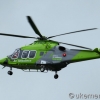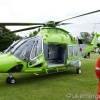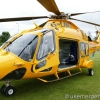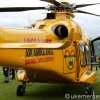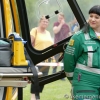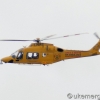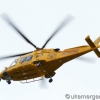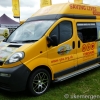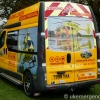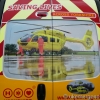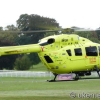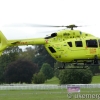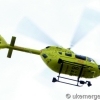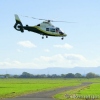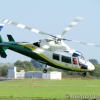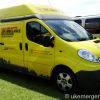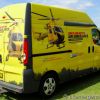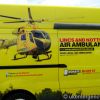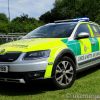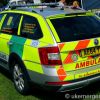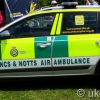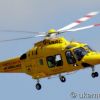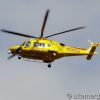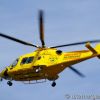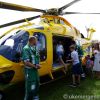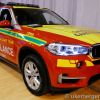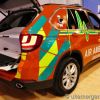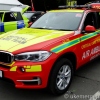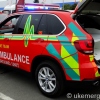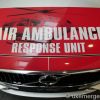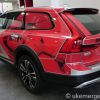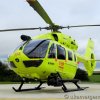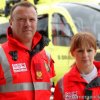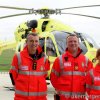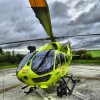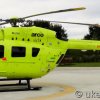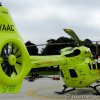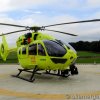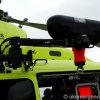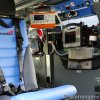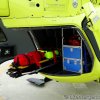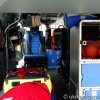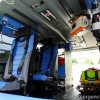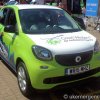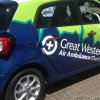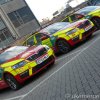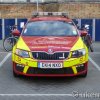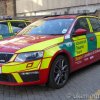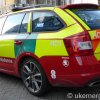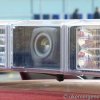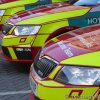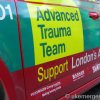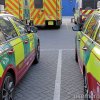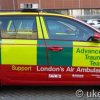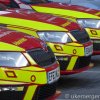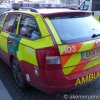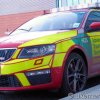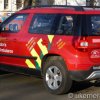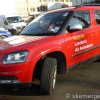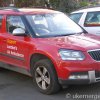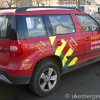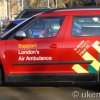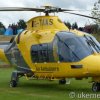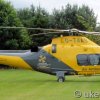Category: Air Ambulance
Airborne ambulance vehicles and their ground support units
G-YAAC Yorkshire Air Ambulance Airbus H145
G-YAAC
Yorkshire Air Ambulance
Airbus H145
This air ambulance entered service at the start of September 2016. It will be joined by a second H145, G-YOAA, before the end of 2016.
The H145s replace two aging MD902 Explorers. The Explorers had seen unprecedented exposure in numerous series of BBC’s Helicopter Heroes. The first series of the programme was presented by Richard Hammond as his way of saying thank you to YAA for saving his life when he crashed while filming for Top Gear.
The new H145 is night-capable, enabling longer flying hours and not leaving medics grounded as soon as the sun sets. It is also fitted with a winch and FLIR camera to see heat rather than light.
London’s Air Ambulance Skoda Octavia VRS providing a ground
London’s Air Ambulance Skoda Octavia VRS providing a ground-based alternative to the helicopter in London. The cars are used when the helicopter is out of action or when weather prevents it flying. They are only used for the most serious medical emergencies.
The images show the sponsors and cameras mounted into the lights bars. The registrations and call signs are:
EK14 NXO [H01]
EF63 MLU [H02]
EK14 NXR [H03]
EK14 NXP [H04]
G-CEMS and G-SASH are the two Yorkshire Air Ambulances. It is unusual …

G-CEMS and G-SASH are the two Yorkshire Air Ambulances. It is unusual for them to be seen together as they are based in and cover different areas of Yorkshire. It is also unusual to see them at night, as they are not permitted to fly then. They are seen here under spotlights, on display as part of the tenth anniversary party of the service at York Racecourse. They flew back into normal operation the next morning.
This is G-SASH, one of the Yorkshire air ambulances…
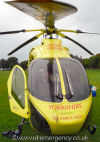
This is G-SASH, one of the Yorkshire air ambulances. This wide-angle shot shows the carefully sculpted angle of the rotor blade. Also in the shot is a TV camera next to the skid. This is used for filming the BBC TV show Helicopter Heroes.
The BBC TV observer helps load the equipment onto the helicopter as the doctor and paramedic return to the craft before taking off to another emergency call.
KN58 LNU is a Seat Leon that is used by Warwickshire…

KN58 LNU is a Seat Leon that is used by Warwickshire and Northampton shire Air Ambulance. It carries a traditional green and yellow livery over the white bodywork.
The rear and side view of the Seat. The companies sponsoring the vehicle are listed on the side, as well as the charity’s helicopter logo. This car replaces a yellow version that can be seen below.
This is G-EHMS, a MD 902 Explorer that has…

This is G-EHMS, a MD 902 Explorer that has been the London Air Ambulance since 2000. The twin engined helicopter has permission to land anywhere to assist with serious medical emergencies. Here it has landed at a cordoned-off road junction. It can get specialist paramedics and doctors to the people who need them, and then transport the casualty to hospital at up to 140 kts.
G-WAAN This is a Great North Air Ambulance Bolkow…

G-WAAN This is a Great North Air Ambulance Bolkow 105 Eurocopter called the Pride of Cumbria. It is the first air ambulance to be based in the county and cover the mountainous Lake District National Park. Initially based at Appleby, then at Penrith police headquarters, the aircraft will be stationed at a custom-built base in the Gillwilly Industrial Estate, Penrith.
The Cumbria air ambulance had a difficult start. It was launched in August 2004 but was grounded in February 2005 due to a lack of funding. It was re-launched six month later.
G-SASH is the Yorkshire Air Ambulance. It is a…

G-SASH is the Yorkshire Air Ambulance. It is a MD902 Explorer and replaced G-PASG in July 2005. With the side door open you can see how a recumbent casualty is loaded onto a swiveling platform.
The side view of the Explorer. It is painted in a bright yellow colour with some sponsors’ adverts. It can take two paramedics to emergencies at up to 154 mph. In addition to the pilot and paramedics, it can carry a stretcher casualty plus two other seated passengers. Notice how the helicopter does not have a rear tail rotor, making it much safer when people are walking around it.
The aircraft lifting off. Because it does not have a tail rotor, the Explorer is one of the quietest aircraft of its kind.
G-WYPA in service with Wiltshire police and ambulance…

G-WYPA in service with Wiltshire police and ambulance services in 2005. This aircraft was previously one of the Great North Air Ambulances (photos lower down the page). Prior to this it was new in 1989 as West Yorkshire’s police helicopter (hence the callsign).

The rear view of the Messerschmitt.
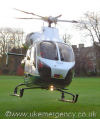
As the Great North Air Ambulance lifts off the ground the pilot encounters a moment of instability.
A closer look at the front of G-GNAA. It is an MD …

A closer look at the front of G-GNAA. It is an MD Explorer helicopter with a dark green a white livery.
Looking at the rear of the helicopter reveals why it is so suited to air ambulance work: it has no rear tail rotor. This makes it much safer for people to walk around the aircraft. The rotor is replaced with air forced at great speed out of a vent in the tail. This counteracts the spinning of the main rotors and keeps the helicopter stable.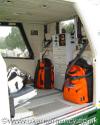
Inside is small, but very tidy and clinical. The orange grab-bags can be seen.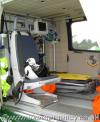
Looking towards the rear of the craft from inside, you can see a seat for the paramedic or doctor caring for the patient on the stretcher. The monitor can also be seen.
The silhouetted view of the underside of the helicopter.
This is G-WYPA, one of the two great north air ambulances…

This is G-WYPA, one of the two great north air ambulances, in flight. Re-liveried and re-launched in March 2003, this Messerschmitt Bolkow Bohlm is based at Teesside Airport. This is the only air ambulance outside of London to carry a specialist NHS doctor on board as well as a paramedic.
The side view of the helicopter in flight. This air ambulance used to be a police helicopter for West Yorkshire Police from 1989-2001. It was built in Germany and the chief police pilot at the time flew it from the factory to West Yorkshire.
A closer look at the livery of G-WYPA.
G-NAAS: The North East Air Ambulance. These photographs…

G-NAAS: The North East Air Ambulance. These photographs were taken in the early 1990s when the aircraft was based at Kitty Brewster Industrial Estate, Blyth. This air ambulance has seen numerous liveries since its introduction and covered the whole of the North East of England.
The same helicopter in flight.
A grounded G-NAAS.
Another view of G-NAAS
Another view of G-NAAS.
This is G-PASG, a Messerschmitt Bolkow Blohm, the…

This is G-PASG, a Messerschmitt Bolkow Blohm, the Yorkshire Air Ambulance. Still in it’s familiar yellow ‘AA’ livery (even though the sponsorship has ended) it has the same colour scheme as most of the air ambulances in the UK. It’s ‘PAS’ callsign is from its owners Police Aviation Services, now known as Specialist Aviation Services.
A patient who was thrown from a horse in the North York Moors has been airlifted to hospital. They are removed from the air ambulance on a stretcher and placed in a road ambulance for the short drive to the accident and emergency department.
The three-man crew of the helicopter prepare to take off to another emergency in West Yorkshire. While the pilot begins to start the engines, the two paramedics load the equipment into the back. The pilot is employed by the ambulance service but is not medically trained.
The stretcher is pushed through from the back of the helicopter so that the head appears next to the rear-seated paramedic. All of the same equipment found on a road ambulance is to hand, but in fewer numbers to keep the weight down.
The second paramedic makes one last check of the area prior to take-off. The rotors are almost at full-speed as the pilot radios air traffic control to request priority status for the emergency journey.
Immediately after taking-off the helicopter skims over the ground at only a few feet before rising almost vertically.
A rather scenic shot of the air ambulance as it makes haste towards the sun.

